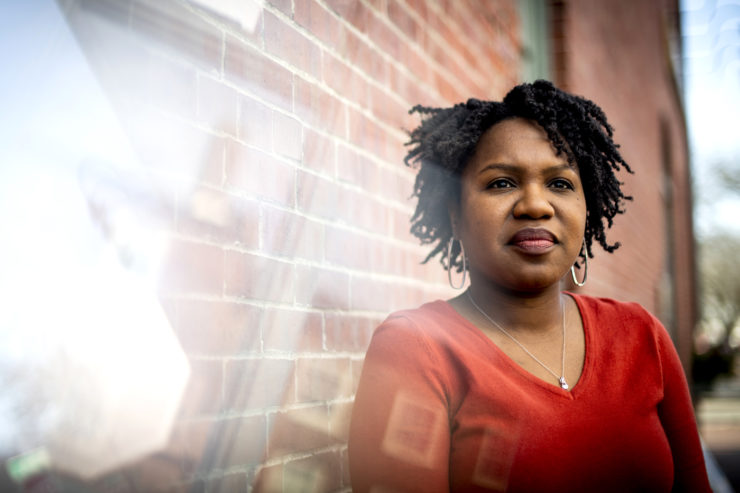For decades, women have used chemical straightening products on their hair. Now, studies show that the use of these products may lead to an increased risk for uterine cancers, prompting the U.S. Food and Drug Administration to propose a ban on hair relaxers that emit formaldehyde.
A study from researchers at the National Institutes of Health published last year found women who use chemical hair straightening products were almost twice as likely to develop uterine cancer than those who didn’t use these products. In response, the FDA is considering a ban on hair-straightening products that contain or emit formaldehyde, a carcinogen in many of these formulas.
Further research is needed to prove these products are what’s causing the cancer, the study says. But Roger Giese, professor of chemistry and biomedical science and director of the Environmental Cancer Research Program at Northeastern University, says these early results are enough to prompt concern.
“Epidemiology studies are the key to get things going,” he says. “There’s always these confounding factors. … But I think in this case it’s pretty clear that formaldehyde is a real worry. We know it’s a carcinogen. We know how it is a carcinogen. The results have been pretty sharp.”
The study also pointed out the impact these products have on Black women since they are more likely to use chemical straighteners. Most of the study participants who used straighteners identified as Black.
“Because Black women use hair straightening or relaxer products more frequently and tend to initiate use at earlier ages than other races and ethnicities, these findings may be even more relevant for them,” says study author Che-Jung Chang, Ph.D. in an article published by the NIH.
The use of these products are about more than just aesthetics, says Kabria Baumgartner, dean’s associate professor of history and Africana studies and the associate director of public history at Northeastern. They tie into a history of Black women being judged for wearing their hair with its natural texture.

“Too often Black hair has been fodder for debates about beauty,” Baumgartner says. “I think, for Black women especially, it’s been complicated. … There’s often the sense that we are judged no matter how we wear our hair. Some women might feel more pressure to use hair-straightening products.”
Black people — especially women — who wear their hair in natural styles have been subject to judgment and discrimination, Baumgartner says. A study from Dove of Black women and girls found at least 53% of young girls faced hair-based discrimination as early as age 5. At the same time, 81% of Black girls in majority-white schools who partook in the survey said they sometimes wish they had straight hair.
Many states have passed laws that prevent hair-based discrimination. U.S. Rep. Ayanna Pressley of Massachusetts has advocated for the passage of this type of a law at a national level, saying last year in a speech to the House that in Massachusetts, there were cases of Black girls being discriminated against for wearing their hair to school in braids.
“For too long, Black girls have been discriminated against and criminalized for the hair that grows on our heads and the way we move through and show up in this world,” Pressley said in during the speech. “In my home state, the commonwealth of Massachusetts, two twin sisters, Deanna and Mya, high school students, were disciplined for showing up with braids. They were given numerous detentions, kicked off the track team, banned from prom, solely for their hairstyle. In their own words, these scholars and athletes were judged more for their heritage than their homework.”
The CROWN Coalition, the official campaign of the CROWN Act, found this perception continues into adulthood. Research from the Coalition found Black women felt their natural hair is 2.5 times as likely to be viewed as unprofessional. About two-third of survey respondents change their hair for job interviews.
The history of Black women’s hair care products goes back, at least, to the early 1900s when Madam C.J. Walker invented a now-famous line of hair products and straighteners for Black women called “Madam Walker’s Wonderful Hair Grower.” This kicked off a long history of Black women entrepreneurs creating these sorts of products for other Black women who used them along with hot combs to achieve straight hair. This became an alternative to African hair braiding, a tradition that Baumgartner says goes back centuries. Walker and other Black hair entrepreneurs, however, did not seem to use known carcinogens like formaldehyde in their products.
The 1960s and ’70s brought about the Black Power Movement and with it, the reclaiming of natural hair styles for Black women, Baumgartner says.
“In my own personal experience, I’ve seen Black women embracing natural hairstyles instead of straightening their hair using products containing harmful chemicals,” Baumgartner says. “It may be in part because we see more Black women leaders who are wearing their hair naturally. We see Black women celebrities wearing their hair naturally and embracing it. There’s wonderful versatility with Black hair. It doesn’t have to be worn one particular way. Every woman can determine how she wants to wear her hair and she shouldn’t be discriminated against or feel pressured.”
Baumgartner hails the potential ban as “a move in the right direction.”
“We’ve known for a while that there are harmful chemicals in hair straighteners and other hair care products,” Baumgartner says. “I think we ought to be looking at what kinds of chemicals are in all of our hair and beauty products.”
Erin Kayata is a Northeastern Global News reporter. Email her at e.kayata@northeastern.edu. Follow her on X/Twitter @erin_kayata.
This post was originally published on this site be sure to check out more of their content.







